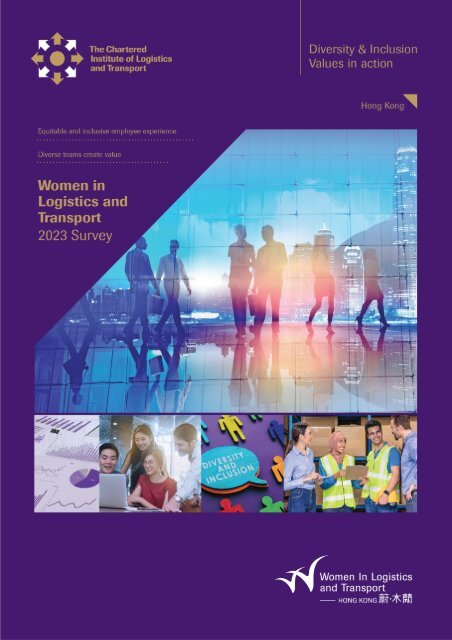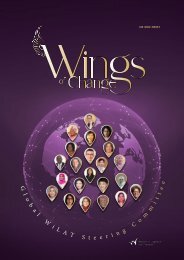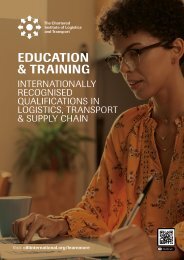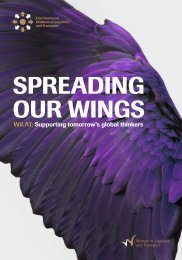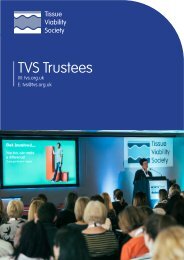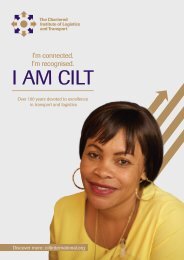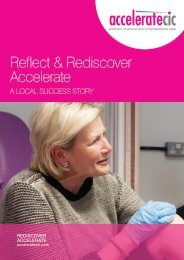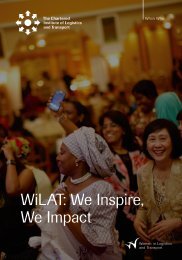WiLAT Survey Report 2023
Survey of Women in Logistics and Transport (WiLAT)
Survey of Women in Logistics and Transport (WiLAT)
You also want an ePaper? Increase the reach of your titles
YUMPU automatically turns print PDFs into web optimized ePapers that Google loves.
1 Women in Logistics and Transport – <strong>2023</strong> <strong>Survey</strong><br />
Contents<br />
Executive Summary…….......…...…………………..………………………………2-3<br />
Foreword…………………………………..………………………………………………...4<br />
Introduction…………………………………………………………………………………5<br />
Purpose and Objectives of the <strong>Survey</strong>……………………………………....……….6<br />
<strong>Survey</strong> Background…………………….….………………………...……..………...…7-9<br />
Respondents……………………………………...………..……………………………10<br />
<strong>Survey</strong> Methodology / Working Team….……………………………..…………..…11<br />
Major Findings…………..…………………..…………………………..………….12-28<br />
Conclusion…………………………………..…………………………………….…29-30<br />
Recommendations……………………….…..……………………………………..31-34<br />
Acknowledgment……………………….…..……………………………….…………..35<br />
References………...……………………….…..…………………………………………..36
2 Women in Logistics and Transport – <strong>2023</strong> <strong>Survey</strong><br />
<strong>Survey</strong> of Diversity and Inclusion Practices by<br />
Transport and Logistics Companies in Hong Kong<br />
Executive Summary<br />
Diversity and Inclusion (D&I) improves organization health and is an enabler for<br />
organizations to cope with changes and continue functioning in a high-performance<br />
workplace culture. Logistics and transport is a male dominated industry where gender<br />
diversity at play would create an impact. Moreover, as globalization and technology<br />
advancement continue, the industry has increasingly become a choice of profession<br />
by women.<br />
To facilitate women engagement in the industry, identifying and sharing company<br />
practices on gender diversity and inclusion are crucial. Through this survey, the current<br />
state of D&I practices was collected from enterprises in logistics and transport. 12<br />
representative enterprises with a total workforce of around 30,000 employees actively<br />
participated in this survey and showed a high degree of support at senior<br />
management level.<br />
Based on first hand dialogue with respondents, it is observed that awareness of D&I is<br />
generally established, and some policies are in place to guide employees’ behavior<br />
at work. However, respondents are also looking for more structured and sustainable<br />
programs to embed D&I as a culture. They do look forward to change agents such as<br />
Women in Logistics and Transport, Hong Kong Chapter (<strong>WiLAT</strong> HK) to step up efforts for<br />
D&I support. <strong>WiLAT</strong> HK is committed to working with the participating companies as an<br />
on-going effort.<br />
From the responses collected, a good list of practices is summarized by category -<br />
namely “Policies at work”, “Information sharing”, “Facility and Service support”, and<br />
“Social events” - for employers in the industry to draw reference from.
3 Women in Logistics and Transport – <strong>2023</strong> <strong>Survey</strong><br />
Policies at work:<br />
● Employee assistance hotline/<br />
program<br />
Information sharing:<br />
● Annual D&I survey to collect<br />
employee opinions<br />
●<br />
Extended maternity leave<br />
●<br />
D&I material written in books and<br />
●<br />
Flexible working hours for<br />
paintings.<br />
pregnancy, breastfeeding and<br />
●<br />
D&I week<br />
menstruation discomfort<br />
●<br />
Diversity Briefing<br />
●<br />
Health check<br />
●<br />
Games related to D&I<br />
●<br />
Hybrid work arrangement<br />
●<br />
Workshop, seminar, and webinar<br />
●<br />
Mentorship program with female<br />
●<br />
World Men’s Day activities<br />
mentor<br />
●<br />
World Women’s Day activities<br />
●<br />
Paternity leave<br />
●<br />
Personal leave<br />
●<br />
Work from home due to<br />
childcare during the pandemic<br />
Facility and Service support<br />
● Lactation room/nursery<br />
● Increase female washroom and<br />
Social events<br />
● Cross company activities<br />
● Events on homosexual<br />
better conditions<br />
relationship & health awareness<br />
●<br />
Posters on snapshot boards<br />
●<br />
Events on sexual harassment &<br />
●<br />
Gender neutral washroom<br />
discrimination<br />
●<br />
Social gatherings such as BBQ<br />
and hiking<br />
●<br />
Yoga classes
4 Women in Logistics and Transport – <strong>2023</strong> <strong>Survey</strong><br />
Foreword<br />
Following the last survey conducted in 2018, this is the fourth industry-wide survey<br />
conducted by <strong>WiLAT</strong> HK with an aim to promote female employment and talent<br />
retention. We appreciate the due attention shown by senior management of the<br />
participating companies and their increasing involvement in creating and<br />
implementing D&I practices. Their interest and concern pointed to D&I as a growing<br />
attribute regarding female employment and talent retention.<br />
<strong>WiLAT</strong> HK is pleased to have gained the full support of the participating companies in<br />
making this survey another success. Although they do not consider gender gap as a<br />
barrier in hiring and retaining female employees for them, these organizations are<br />
keen to introduce more D&I practices to reap the benefits. They also look forward to<br />
<strong>WiLAT</strong> HK organizing more programs to further promote it.<br />
From ESG to improved employee engagement, and to AI and new technologies, we<br />
rely on people, and it is the people in the organization that shape the performance.<br />
We are deeply touched by the trust and feedback received and we look forward to<br />
closer collaboration.
5 Women in Logistics and Transport – <strong>2023</strong> <strong>Survey</strong><br />
Introduction<br />
The Chartered Institute of Logistics and Transport (CILT)<br />
http://www.ciltinternational.org is a leading global professional body for those<br />
engaged in the transport, supply chain and logistics industry, including air, sea and<br />
land for both passengers and freight transportation across the globe. In Hong Kong,<br />
CILT HK http://www.cilt.org.hk provides career development and professional training<br />
opportunities and sets the highest standards of professional practices through a<br />
comprehensive qualification framework and professional exchanges with different<br />
clusters of excellence led by committees within CILT HK.<br />
Women in Logistics and Transport, Hong Kong Chapter (<strong>WiLAT</strong> HK) is a committee<br />
under CILT HK founded by a group of members in CILT HK in 2012. It also belongs to<br />
Global <strong>WiLAT</strong> which supports <strong>WiLAT</strong> in different territories. The mission of Global <strong>WiLAT</strong><br />
is to promote the status of women in the logistics and transport industry, to bring<br />
together those who support talent and career development of women and to provide<br />
a support network and mentoring opportunities for women in the logistics and<br />
transport sector http://www.wilat.org.<br />
Global <strong>WiLAT</strong> was launched by CILT in June 2013. By 2022, <strong>WiLAT</strong> had over 3,250<br />
members in 34 territories, and we are still growing. A book was published in 2022 to<br />
capture <strong>WiLAT</strong>’s growth over the past 10 years. The publication is called ‘Spreading<br />
Our Wings’ https://www.wilat.org/webook-sow as it’s about where we want to go, not<br />
just where we have been.<br />
<strong>WiLAT</strong> HK, under CILT HK, is committed to supporting the promotion of D&I practices to<br />
our industry players.
6 Women in Logistics and Transport – <strong>2023</strong> <strong>Survey</strong><br />
Purpose and Objectives of the <strong>Survey</strong><br />
There are 4 key areas:<br />
1. Identify diversity and inclusion initiatives. Noting that diversity and inclusion<br />
could include race, ethnicity, gender and so forth, our main focus is on the<br />
female gender.<br />
2. Explore diversity policies and practices in an organization relevant to the<br />
female gender.<br />
3. Study inclusion practices and identify best practices that could be adopted by<br />
organizations.<br />
4. Provide constructive recommendations for logistics and transport companies<br />
on diversity and inclusion practices for the female gender.
7 Women in Logistics and Transport – <strong>2023</strong> <strong>Survey</strong><br />
<strong>Survey</strong> Background<br />
The research study is the fourth industry-wide survey commissioned by <strong>WiLAT</strong> HK, a<br />
committee under CILT HK, encouraged by the support given by Ir Dr. Kelvin Leung, CILT<br />
HK President.<br />
<strong>WiLAT</strong> HK is committed to promoting diversity, in particular female participation in our<br />
industry. The first industry-wide survey was conducted in 2012, followed by the second<br />
one in 2014; and then the third in 2018 with participants responding to an online survey<br />
to identify the key factors for encouraging or hindering female participation in the<br />
transport and logistics sector. The last survey came up with several recommendations,<br />
one of which is to empower female participation through training. Global <strong>WiLAT</strong><br />
established <strong>WiLAT</strong> Capacity Building Centre (WCBC), the first of its kind, in 2021 to<br />
provide development programs for female leadership, and to encourage transfer of<br />
the latest industry expertise for advancement of practitioners in the ever-changing<br />
world of supply chain, logistics and transport. WCBC was established under the<br />
chairpersonship of Vicky Koo, who was the then <strong>WiLAT</strong> HK Chairperson and she will<br />
assume the role of Global <strong>WiLAT</strong> Chairperson from 1 July <strong>2023</strong>.<br />
The study began with desktop research on general diversity and inclusion definitions,<br />
followed by mapping questions relevant to the objectives of the survey for targeted<br />
organizations.<br />
Diversity refers to the differences that exist between individuals such as race, gender<br />
identity, age, culture, religion and socio-economic status. Inclusion means creating an<br />
environment where these differences are valued, respected and appreciated and it<br />
is usually reflected in equity, openness and belonging.<br />
Various literature and studies have explored the impact of diversity and inclusion<br />
practices. McKinsey and Company’s studies on ‘Why diversity matters’ (2015) and<br />
‘Delivering through diversity’ (2018) and ‘Diversity Wins’ (2019) show that the<br />
relationship between diversity on executive teams and the likelihood of financial<br />
outperformance has strengthened overtime. The reports also provide new insights into
8 Women in Logistics and Transport – <strong>2023</strong> <strong>Survey</strong><br />
how inclusion matters and that it would be appropriate that companies should pay<br />
much greater attention to inclusion even when they are relatively diverse. The 2019<br />
analysis finds that companies in the top quartile for gender diversity on executive<br />
teams were 25% more likely to have above-average profitability than companies in<br />
the fourth quartile – up from 21 % in 2017 and 15% in 2014.<br />
Yet progress has been slow. McKinsey’s global data show that gender diversity with<br />
female representation on executive teams moved up just one percentage point to<br />
15% in 2019 from 14% in 2017; and on the representation of ethnic minorities, this<br />
proportion was 14% in 2019 and 12% in 2017.<br />
By analysing surveys and company research, McKinsey found that different<br />
approaches to diversity and inclusion matter with two critical factors: a systematic<br />
business-led approach and bold action on inclusion. To tap into the effectiveness of<br />
various measures, McKinsey found that ‘social listening’ focusing on sentiments in<br />
employees’ reviews can provide useful indicators on matters that count.<br />
According to Hive HR, Platform in the UK https://www.hive.hr/contact/ it is important<br />
to think of inclusion first: ‘If every employee isn’t having an equitable and inclusive<br />
employee experience, the diversity figures don’t matter.’ However, diversity in itself is<br />
a worthy goal for any organization: diversity teams solve problems faster, diverse<br />
organizations are employers of choice, employees of diverse organizations are more<br />
engaged, diverse teams perform better and are more innovative and diverse<br />
leadership teams are more effective.<br />
Hong Kong is ranked number one in the Urban Mobility Index. According to the World<br />
Economic Forum, Hong Kong’s Mass Transit has the highest usage rate of public<br />
transport in the world and over 90% of Hong Kong’s daily commuter trips are made on<br />
public transport. It also has the world’s busiest airport and container ports and is Asia’s<br />
most prominent financial hub. However, it is also faced with an aging population and<br />
declining birth rate, and is under the traditional influence that females are to attend<br />
to family duties. Bolder measures may be needed to bring the best out of the hardworking<br />
population with different backgrounds, commitments, and aspirations.
9 Women in Logistics and Transport – <strong>2023</strong> <strong>Survey</strong><br />
A phenomenon post-pandemic is that the demand for labour has out stripped supply.<br />
The transportation and logistics sector has been particularly hard hit. Both labour<br />
recruitment and retention are faced with difficulties and work practices are also<br />
evolving. While employers are looking at compensation and job offers as important<br />
factors, employees also place great value on the sense of belonging and their peers.<br />
Our survey is meant to understand the gender diversity and inclusion practices among<br />
major transport and logistics organizations; and given the importance of such<br />
initiatives to the overall performance of organizations, what suggestions we can make<br />
to unleash the potential of diversity and inclusion practices and bring bigger<br />
employee satisfaction and performance. Especially in the talent shortage situation,<br />
we wish to assist organizations to be the preferred choice of employers among others.
10 Women in Logistics and Transport – <strong>2023</strong> <strong>Survey</strong><br />
Respondents<br />
The opening question for any organization would be their mission, commitment and<br />
understanding towards diversity and inclusion. 21 companies have been identified to<br />
represent a wide spectrum of activities in the relevant fields. Out of these companies,<br />
12 companies have responded to our requests for interview on the survey topic. They<br />
employ a total of around 30,000 employees in their Hong Kong offices, and most of<br />
them are listed companies and leading performers in the industry. The list of<br />
companies is presented in the Acknowledgement section toward the end of this<br />
report.<br />
For reference purposes, the number of employees in the “Transportation, storage,<br />
postal and courier services” industry was 162,743, out of which 108,574 being males<br />
and 54,168 females, as reported in the Quarterly <strong>Report</strong> of employment and<br />
Vacancies Statistics in December 2022 by the Census and Statistics Department of the<br />
Hong Kong Government. Our survey population represented about 18% of this group.
11 Women in Logistics and Transport – <strong>2023</strong> <strong>Survey</strong><br />
<strong>Survey</strong> Methodology<br />
The 12 companies were given a set of pre-set questions and they were asked to<br />
nominate representatives at various levels to participate in the survey. We are able to<br />
conduct interviews with 23 representatives (all companies nominated 2-3<br />
representatives to take part in the interviews, except one with only one representative).<br />
Among all respondents, very senior executives and company managers were<br />
involved.<br />
Interviews were conducted between October and December 2022 by <strong>WiLAT</strong> HK<br />
members and the appointed academic associate. Owing to the COVID-19 pandemic,<br />
all interviews were conducted via an online platform without recording. The duration<br />
of the interviews varied from 45 to 60 minutes as some respondents had more to share<br />
on the topic being surveyed. As the interviews progressed, key observations were<br />
captured, and in some cases follow-up questions were raised for comprehensiveness.<br />
As the survey was conducted during the COVID-19 pandemic, a specific question was<br />
put to the companies on assistance to female employees as they are prone to stress<br />
arising from family needs.<br />
Working Team<br />
In 2022, <strong>WiLAT</strong> HK formed a Working Team led by Kenneth Law, <strong>WiLAT</strong>’s lead person on<br />
diversity and inclusion, to undertake the survey project. Data analysis and report<br />
presentation were undertaken by Kenneth Law, Dorothy Chan, Vicky Koo, Carmen Li,<br />
Sunny Shih and Alice Yip. Dr. Joseph Lau and his assistant took part in designing<br />
questions and in conducting interviews.
12 Women in Logistics and Transport – <strong>2023</strong> <strong>Survey</strong><br />
Major Findings / Responses to the survey<br />
Question 1<br />
Has your company rendered support to your employees to participate in diversity and<br />
inclusion workshops/online training/seminars/webinar on gender? What is the reason?<br />
Please provide relevant examples if applicable.<br />
Findings:<br />
Figure 1 shows 10 out of 12 companies confirmed they rendered support to their<br />
employees to participate in diversity and inclusion workshops online<br />
training/seminars/webinar in general, whereas one particular company highlighted<br />
their support for the topic of gender in diversity and inclusion related activities. Two<br />
companies did not support either due to budget constraint or they did not see the<br />
business needs. The reasons for supporting diversity and inclusion activities vary from<br />
company to company and reflect the unique business environments and objectives<br />
of the companies. Six companies aimed to develop an inclusive team and increase<br />
staff awareness across multiple diversity and inclusion topics. Two companies aimed<br />
to promote gender balance, equal opportunities, anti-discrimination, and anti-sexual<br />
harassment in the workplace. Two companies aimed to attract and retain female staff<br />
and to promote the proposition that the logistics and transport industry is no longer<br />
male dominant and that females are also playing an important role.<br />
Generally speaking, due to the financial constraints and social distancing restrictions<br />
during the COVID-19 pandemic, most companies replaced physical training sessions<br />
and workshops by online training, seminars, webinars and email circulation of<br />
information on diversity and inclusion.
13 Women in Logistics and Transport – <strong>2023</strong> <strong>Survey</strong><br />
Figure 1: Has your company rendered support to your employees to participate in<br />
diversity and inclusion workshops/online training/seminars/webinar on gender?<br />
2,<br />
17%<br />
Yes<br />
No<br />
10,<br />
83%
14 Women in Logistics and Transport – <strong>2023</strong> <strong>Survey</strong><br />
Question 2<br />
Has your company organized diversity and inclusion activities on gender in the<br />
workplace? What is the reason?<br />
a. Diversity briefings<br />
b. Recreational activities<br />
c. The snapshot boards<br />
d. Social gatherings<br />
e. Story sharing via internal communication<br />
f. Mini events<br />
g. Office decoration<br />
h. None of the above<br />
Findings:<br />
Figure 2 shows that the top four diversity and inclusion activities organised by the<br />
companies were “Diversity Briefing”, “Recreational Activities”, “Social Gathering” and<br />
“Story Sharing”. 11 out of 12 companies organized “Diversity Briefing”, 10 out of 12<br />
companies organized “Recreational Activities”, “Social Gathering” and “Story<br />
Sharing”. However, it is important to understand that diversity and inclusion activities<br />
reflect the unique business environments and objectives of the company as well as<br />
their management’s understanding of the topic; therefore the content of the same<br />
activity type varies from company to company. For example, in “Diversity Briefing”,<br />
there were companies providing information about "Equal Opportunities”, “Antidiscrimination<br />
and Anti-sexual Harassment in workplace” to their employees. Other<br />
companies were providing information on the latest trends in the diversity briefing. Last<br />
but not least, one company mentioned that they incorporated company policy<br />
information on “Diversity and Inclusion” in the briefing to their employees and<br />
explained the reason behind promoting such policies was to inculcate a diverse and<br />
inclusive workplace. The project team has consolidated the list of activities and<br />
contents into the recommendations for reference.
15 Women in Logistics and Transport – <strong>2023</strong> <strong>Survey</strong><br />
Figure 2: Has your company organized diversity and inclusion activities on gender in<br />
the workplace?<br />
0% 25% 50% 75% 100%<br />
a. Diversity briefings<br />
11<br />
1<br />
b. Recreational activities<br />
10<br />
2<br />
c. The snapshot boards<br />
7<br />
5<br />
d. Social gatherings<br />
10<br />
2<br />
e. Story sharing via internal<br />
communication<br />
10<br />
2<br />
f. Mini events<br />
6<br />
6<br />
g. Office decoration<br />
7<br />
5<br />
Yes<br />
No
16 Women in Logistics and Transport – <strong>2023</strong> <strong>Survey</strong><br />
Question 3<br />
Has your company introduced any of the following in the recruitment process?<br />
a. Train the recruitment professionals on diversity and inclusion on gender<br />
b. Train the interviewers about prevention of unconscious bias in the recruitment<br />
process<br />
c. Ensure the diversity of the interview panel<br />
Findings:<br />
Figure 3 shows 11 out of 12 companies provided training in diversity and inclusion, and<br />
prevention of unconscious bias in the recruitment process, to their recruitment<br />
professionals. Despite confirmation by all 11 companies that they provided the training,<br />
only a few interviewees could provide examples of what unconscious bias was and<br />
their preventive actions to address it. Lastly, only two companies ensured diversity of<br />
the interview panel and one company did not answer this question.<br />
Figure 3: Has your company introduced any of the following in the recruitment process?<br />
0% 25% 50% 75% 100%<br />
3a. Train the recruitment professionals on<br />
diversity and inclusion on gender<br />
11<br />
1<br />
3b. Train the interviewers in unconscious<br />
bias in recruitment process<br />
11<br />
1<br />
3c. Ensure the diversity of interview panel<br />
2<br />
9 1<br />
Yes No No Reply
17 Women in Logistics and Transport – <strong>2023</strong> <strong>Survey</strong><br />
Question 4<br />
Are there flexible working hours/fractional appointments of women introduced within<br />
your company’s management board/committee or on job level? What is the reason?<br />
Please provide relevant examples if applicable.<br />
Findings:<br />
Figure 4 shows nine out of 12 companies introduced flexible working hours to their<br />
employees, applicable only to pregnant employees or those having breastfeeding<br />
needs. Two companies offered work from home arrangements providing flexible<br />
working hours. It is important to note that working hours in the transport and logistics<br />
industry are commonly on rostering basis, especially for the frontline operations, mostly<br />
requiring 24/7 work arrangements instead of typical 9am to 6pm working hours.<br />
Therefore, flexible working hours would mean a request to change the work schedule<br />
rather than simply adjusting or shortening working hours. Apart from this, it is impossible<br />
to have work from home or hybrid practices for frontline employees whose job duties<br />
require physical operation of vehicles or machinery.<br />
Thus, the industry will usually offer flexible working hours to employees who are<br />
pregnant or having breastfeeding needs. Under the circumstances, there are two<br />
highlights worth noting in one of the companies,<br />
- it provided 24 weeks of paid maternity leave, approximately 5.5 months, to their<br />
female employees which is 10 weeks more than stipulated by the laws of Hong<br />
Kong.<br />
- at the same time, it also provided 14 days of paid paternity leave to male<br />
employees which is 9 days more than stipulated by the laws of Hong Kong.<br />
Apart from the captioned, one company provided extra two days of paid personal<br />
leave per annum to all employees, regardless of the reasons.<br />
To conclude, the successful implementation of flexible working hours and other paid<br />
leave benefits would require company policy support, practicality to the job functions<br />
and are highly dependent on the business conditions. A list of policies is summarised<br />
below for reference:
18 Women in Logistics and Transport – <strong>2023</strong> <strong>Survey</strong><br />
- Extended maternity leave<br />
- Extended paternity leave<br />
- Flexible working hours particularly for pregnancy, breastfeeding needs, and<br />
menstruation discomfort<br />
- Personal leave<br />
- Work from home due to childcare during the pandemic<br />
Figure 4: Is there any flexible working hours practice introduced within your company?<br />
3<br />
25%<br />
Yes<br />
No<br />
9<br />
75%
19 Women in Logistics and Transport – <strong>2023</strong> <strong>Survey</strong><br />
Question 5<br />
Are there any well-being programs or mental-health benefits tailor-made for women<br />
offered before or during the COVID-19 pandemic? Please provide relevant examples<br />
if applicable?<br />
Findings:<br />
Figure 5 shows that 11 out of 12 companies provided well-being programs or mentalhealth<br />
benefit programs to their employees before or during COVID-19. But these were<br />
for all employees regardless of gender. Only one company had tailored the program<br />
to female employees during COVID-19 - they offered a shift of work location and an<br />
extension of vaccination requirement if the employee was undergoing breastfeeding.<br />
Figure 5: Are there any well-being programs or mental-health benefits tailor-made for<br />
women offered before or during the COVID-19 pandemic?<br />
0% 25% 50% 75% 100%<br />
Have programs before COVID-19?<br />
11<br />
1<br />
Have programs during COVID-19?<br />
11<br />
1<br />
Have tailored programs for women during<br />
COVID-19<br />
1<br />
11<br />
Yes<br />
No
20 Women in Logistics and Transport – <strong>2023</strong> <strong>Survey</strong><br />
Question 6<br />
Has your company provided mentorship programs for young female employees?<br />
What is the reason? Please provide relevant examples if applicable.<br />
Findings:<br />
- Figure 6 shows 11 out of 12 companies confirmed they had mentorship programs<br />
for employees. Seven out of 12 companies had mentorship programs for young<br />
female employees - these companies recognised the mentoring needs between<br />
male and female were different. Therefore, they offered fine-tuned programs for<br />
females where necessary. One company had no mentorship program for<br />
employees.<br />
- There are mainly three kinds of practices in the female mentorship program.<br />
Subject to the organizations’ resource availability, needs and mentees’<br />
expectation, they may:<br />
o<br />
o<br />
o<br />
offer a female mentor to the female mentee<br />
provide a mentor that has relevant job experience to the female mentee<br />
collaborate with women’s group or other organizations to provide the<br />
mentorship program<br />
Figure 6: Has your firm provided mentorship programs for young female employees?<br />
0% 25% 50% 75% 100%<br />
Mentorship programs for employees<br />
11<br />
1<br />
Mentorship programs for young female<br />
employees<br />
7<br />
5<br />
Yes<br />
No
21 Women in Logistics and Transport – <strong>2023</strong> <strong>Survey</strong><br />
Question 7<br />
What are the greatest barriers to increasing diversity (i.e. gender issue) in your<br />
company’s workforce?<br />
Findings:<br />
Figure 7 shows eight out of 12 companies replied that they did not have barriers in<br />
increasing gender diversity in their workforce. One company mentioned that due to<br />
the widely accepted social norm and reducing physical demand of logistics and<br />
transport jobs, more women were willing to join the industry. The other companies<br />
believed that the extended paid maternity leave policy was attractive to the female<br />
staff.<br />
The other companies mentioned the main barrier to increase workforce gender<br />
diversity was related to frontline operations which required frontline working hours.<br />
Frontline jobs are usually 24/7 or on a rostering basis, hence not attractive to females<br />
who will consider both work and family commitments in their career development.<br />
Multiple companies mentioned that resource was one of the barriers. It would take<br />
two to three times more efforts to implement D&I activities for frontline workers who are<br />
on two to three work shifts.<br />
Last but not least, one company mentioned that insufficient hygiene facilities such as<br />
the number of female washrooms was a barrier. This could well be a major potential<br />
factor overlooked by most of the companies.
22 Women in Logistics and Transport – <strong>2023</strong> <strong>Survey</strong><br />
Figure 7: Do you have barriers to increase diversity in your workforces?<br />
8<br />
67%<br />
4<br />
33%<br />
Yes<br />
No<br />
To summarize, some of the barriers are:<br />
−<br />
−<br />
−<br />
frontline working hours which demand 24/7 and on duty roster<br />
insufficient hygiene facilities<br />
limitations in providing D&I activities to promote diversity and inclusion for<br />
frontline staff<br />
As the industry and business models are evolving, we believe that employers do have<br />
the capacity to effectively manage changes and remove these barriers.
23 Women in Logistics and Transport – <strong>2023</strong> <strong>Survey</strong><br />
Question 8<br />
Please specify the number of male and female employees in your company as well<br />
as the number of female employees in senior managerial positions.<br />
Findings:<br />
10 companies provided the number of male and female employees. In five<br />
companies, male employees constituted 80% or more; whereas in four companies,<br />
male employees ranged from 50% to 71%. Only one company had female employees<br />
constituting the majority at 70%, and it also had the highest female representation at<br />
senior level.<br />
Figure 8 shows that one company had an overwhelming 70% representation of female<br />
at senior level. Two companies were able to build up a critical mass of 41% - 44% of<br />
female staff. There was one company which had no female in senior managerial<br />
positions at all.<br />
Figure 8: Male and Female Senior Managerial Staff Ratio<br />
0% 25% 50% 75% 100%<br />
Company A<br />
Company B<br />
Company C<br />
Company D<br />
75%<br />
65%<br />
77%<br />
69%<br />
25%<br />
35%<br />
23%<br />
31%<br />
Company E<br />
30%<br />
70%<br />
Company F<br />
56%<br />
44%<br />
Company G<br />
71%<br />
29%<br />
Company H<br />
100%<br />
Company I<br />
77%<br />
23%<br />
Company J<br />
Company K<br />
Company L<br />
59%<br />
67%<br />
75%<br />
41%<br />
33%<br />
25%<br />
Male<br />
Female
24 Women in Logistics and Transport – <strong>2023</strong> <strong>Survey</strong><br />
Question 9<br />
Annual staff turnover rate in your company<br />
a. Last 3-5 years annual staff turnover rate from year 2018 to 2021<br />
b. Turnover rate by gender<br />
c. Turnover rate by Customer Service, Sales & Marketing, Operations, Engineering,<br />
Enabling functions.<br />
d. Turnover rate by managerial and non-managerial positions<br />
Findings:<br />
Only less than half of the companies provided the annual staff turnover rate between<br />
2018 to 2021 with breakdown by gender and number of headcounts. Instead, they<br />
provided turnover rate by departmental functions. The project team is unable to<br />
compile a figure on question 9a and 9b to show any trends or developments to either<br />
attract or retain female workforce in the industry.<br />
Turnover Rate<br />
2018 2019 2020 2021 Average<br />
by Function<br />
Customer Service 13.4 20.1 9.2 10.0 13.2<br />
Sales & Marketing 9.3 6.8 8.5 4.9 7.4<br />
Operation 3.5 4.7 3.2 3.9 3.8<br />
Engineering 4.2 3.4 1.4 1.6 2.7<br />
Enabling Functions 4.0 7.0 2.9 5.9 5.0<br />
In terms of functional average turnover rate between 2018 and 2021, Customer<br />
Service demonstrated the highest average turnover rate at 13.2%, followed by Sales<br />
and Marketing at 7.4%. The third highest average turnover rate was Enabling Functions<br />
at 5.0%. The two functions with the lowest average turnover rates were Operations and<br />
Engineering exhibited at 3.8% and 2.7% respectively.
25 Women in Logistics and Transport – <strong>2023</strong> <strong>Survey</strong><br />
Figure 9: Staff Turnover Rate by Function 2018-2021<br />
22%<br />
20%<br />
18%<br />
16%<br />
14%<br />
12%<br />
10%<br />
8%<br />
6%<br />
4%<br />
2%<br />
0%<br />
2018 2019 2020 2021<br />
Customer Service Sales & Marketing Enabling Functions Operations Engineering<br />
Turnover Rate<br />
by Position<br />
Managerial<br />
2018 2019 2020 2021 Average<br />
6.2 4.2 6.6 6.8 6.0<br />
position<br />
Non-Managerial<br />
position<br />
10.0 11.1 8.0 23.2 13.1<br />
The turnover rate by managerial position was 6.0% on average. For non-managerial<br />
positions, the turnover rate was 13.1% on average and as high as 23.2% in 2021. Thus,<br />
most of the organizations expressed that they were facing pressure in front-line staff<br />
recruitment.
26 Women in Logistics and Transport – <strong>2023</strong> <strong>Survey</strong><br />
Question 10<br />
How important are the following reasons for driving employees to leave the company?<br />
a. Family reasons including emigration<br />
b. Better prospects/ higher salary of the new job<br />
c. Job nature not fit<br />
d. People/culture not fit<br />
e. Downsizing/organization restricting<br />
f. Workload overwhelmed<br />
g. Lack of career development opportunity and training<br />
h. Lack of recognition<br />
i. Remuneration and benefit<br />
Findings<br />
Based on exit interviews conducted with departing staff, all reasons were within 1st,<br />
2nd and 3rd choices except one, which was lack of recognition. It can therefore be<br />
deduced that employees felt their companies had been giving sufficient recognition<br />
for good performance.<br />
In relativity, three main reasons stand out:<br />
a. Family reasons including emigration<br />
b. Better prospects/higher salary of the new job<br />
c. Remuneration and benefits<br />
Also important are:<br />
a. Job nature<br />
b. Lack of career development opportunity and training<br />
Family factor being one of the main reasons, it would be conducive to staff retention<br />
if employers could be more understanding and appreciative of the pressures and<br />
challenges their staff are facing outside the work environment.
27 Women in Logistics and Transport – <strong>2023</strong> <strong>Survey</strong><br />
Figure 10: Top 3 reasons for leaving the company<br />
Percentage of<br />
1st Choice<br />
Percentage of<br />
2 nd Choice<br />
Percentage of<br />
3rd Choice<br />
a. Family reasons including<br />
emigration<br />
b. Better prospects/higher salary of<br />
the new job<br />
50% 8% 30%<br />
42% 25% 30%<br />
c. Job nature not fit 0% 25% 0%<br />
d. People/culture not fit 0% 0% 10%<br />
e. Downsizing/organization restricting 0% 0% 10%<br />
f. Workload overwhelmed 0% 0% 10%<br />
g. Lack of career development<br />
opportunity and training<br />
0% 17% 0%<br />
h. Lack of recognition 0% 0% 0%<br />
i. Remuneration and benefits 8% 25% 10%
28 Women in Logistics and Transport – <strong>2023</strong> <strong>Survey</strong><br />
Question 11<br />
If <strong>WiLAT</strong> HK organizes diversity and inclusion activities on gender, any particular topics<br />
or activities you think would be useful?<br />
Findings:<br />
In terms of D&I activities on gender, 50% of the responses from companies suggested<br />
social gatherings such as cross company activities, happy hour and story-sharing by<br />
role models. 60% of the responses suggested formal functions such as workshops,<br />
sponsored training sessions, webinars and liaison with educational institutions. 42%<br />
suggested to increase the public awareness about female status in the industry, while<br />
the same 42% would consider the mode of delivery, venue and duration to be their<br />
prime considerations for <strong>WiLAT</strong> HK events.<br />
Stress management and female rights were topics brought up by two companies, but<br />
apart from that, despite the overwhelming response, the other companies did not<br />
suggest any specific topics of interest other than the general awareness of female in<br />
the industry. There are companies that considered that regardless of gender, activities<br />
should be organized around the theme of diversity and inclusion.
29 Women in Logistics and Transport – <strong>2023</strong> <strong>Survey</strong><br />
Conclusion<br />
Based on the survey conducted, diversity and inclusion are not new or alien to the<br />
participating organizations. Some activities have been organized including workshops,<br />
seminars or webinars.<br />
Although most organizations agreed and are interested in a more balanced gender<br />
presence in their workplace, relevant actions regarding female gender could only be<br />
noticed in certain areas such as sexual harassment and pregnancy.<br />
Moreover, training of recruitment personnel on gender considerations is not<br />
comprehensive, hence gender issues are not noticeable on their radar screen. With<br />
that, unconscious bias in recruitment might occur since the industry is labour-intensive.<br />
As regards the composition of recruitment interview panels, only two companies could<br />
ensure gender diversity.<br />
Generally speaking, companies have programs on well-being and mental health; and<br />
mentorship programs are catered to all genders. This seems to be a common practice<br />
in the industry.<br />
But the male/female staff ratio is an issue. One company has a<br />
mentorship program specifically designed for female with a female mentor, and<br />
surprisingly one company does not even have a mentorship program.<br />
In terms of flexible working hours, only companies working without a roster system<br />
could offer this to their female employees. Staff working in a roster system would have<br />
no choice but to switch shifts with other employees if needed.<br />
From the male/female staff ratio, we can easily realize that the transport and logistic<br />
industry is a male dominated industry and thus awareness in female participation has<br />
not been properly noticed and portrayed.
30 Women in Logistics and Transport – <strong>2023</strong> <strong>Survey</strong><br />
Noticeably, a higher male ratio is found in the rank & file positions due to the labourintensive<br />
nature, but a similar ratio is also found in the senior positions of these<br />
companies with only one exception which has a female to male ratio of 70:30 along<br />
with two companies which have built up a critical mass of female representation at<br />
41% - 44%.<br />
For the reasons of staff turnover, there is insufficient input gathered from the survey to<br />
come to a conclusion as to why female employees are leaving the industry.<br />
All in all, there are D&I initiatives in the industry, and it is highly accepted and<br />
recognized by all companies. That said, the entire state of D&I leaves much room for<br />
improvement and desires more to be carried out in greater depth. We expect more<br />
suggestions on Question 11 on what topics <strong>WiLAT</strong> can assist. Companies may have<br />
certain ideas on activities but it is significant for the companies to embrace diverse<br />
and inclusive workplaces under a purpose driven direction by combining the business<br />
case for D&I policies with supportive company values.<br />
Last but not least, it is worth noting that this survey was conducted during an unusual<br />
period of time and those figures on turnover rate would be slightly different had it not<br />
been for the pandemic situation.<br />
The survey findings above points to the fact that a professional body like <strong>WiLAT</strong> under<br />
CILT is relevant and helpful in the industry as it provides feedback channels about<br />
improvement initiatives for enhancing D&I in the workplace at large.
31 Women in Logistics and Transport – <strong>2023</strong> <strong>Survey</strong><br />
Recommendations<br />
For <strong>WiLAT</strong>, we are interested in policies and practices that would help achieve gender<br />
equality in the workplace. Particularly, how a successful organization would<br />
embrace diversity, promote equity, and develop an inclusive culture that motivates<br />
the workforce. Typically, in the transport, supply chain and logistics industry, the global<br />
nature of the business means that individuals regardless of their race, gender, age,<br />
culture, religion, and social economic status are to be brought together to fulfill the<br />
organization’s values.<br />
Our survey is meant to understand the gender diversity and inclusion practices among<br />
major transport and logistics organizations, and given the importance of such<br />
initiatives to the overall performance of organizations, what suggestions we can make<br />
to uncover the potential of diversity and inclusion practices that can bring bigger<br />
employee satisfaction and performance.<br />
Since employees from different backgrounds bring a variety of skills, ideas,<br />
experiences and perspectives, it will translate into teams that can offer greater<br />
innovation and problem-solving capabilities.<br />
This understanding seems widely<br />
accepted, but turning to the female gender, little traits can be found among the<br />
participating companies to encourage women employment. Quantitative data<br />
retained are limited in measuring the gender disparity and turnover. The following<br />
recommendations are made to impel gender diversity.<br />
1. Be transparent about where you stand, acknowledge your strengths and<br />
weaknesses, and set out a clear plan to make change.<br />
2. Share the progress toward achieving a diverse workforce. Keeping record and<br />
data will be helpful for future analysis.<br />
3. Support male employees to avail reasonable time to share domestics tasks with<br />
their spouses, especially those who have elderlies and minors at home. It will<br />
indirectly allow women at work to strike a better work-life balance.<br />
4. Review the hygiene related facilities at work. Women are conscious about<br />
the conditions for personal needs, a typical one being the washrooms.
32 Women in Logistics and Transport – <strong>2023</strong> <strong>Survey</strong><br />
5. In an earlier study by <strong>WiLAT</strong> HK in 2018, recommendations included fractional<br />
employment, transparent human resources policy in promotion, speciality<br />
training and participation in <strong>WiLAT</strong> HK’s Career Advancement and Life Formula<br />
(CALF) program. We recommend employers to revisit these areas and consider<br />
deploying them in business operations. The full report can be found in this<br />
weblink: <strong>WiLAT</strong> Hong Kong <strong>Survey</strong> | website https://www.wilat.org/wilat-hongkong-survey.<br />
At the same time, WCBC has been organizing talks on Diversity,<br />
Equity and Inclusion successfully with industry participants and is launching the<br />
CALF program globally.<br />
6. For companies where female representation at senior level is limited, cross<br />
company projects with other companies with a more prominent presence of<br />
senior female executives may help to embed gender diversity.<br />
7. <strong>WiLAT</strong> HK shall reach out to more companies in the industry to promote diversity<br />
and inclusion, by arousing employers’ awareness and enhancing recognition<br />
for the value of deploying D&I practices.<br />
8. Encourage other <strong>WiLAT</strong> territories to conduct similar surveys to collect practices<br />
internationally, and share across the <strong>WiLAT</strong> platform.<br />
9. Investigate the possibility of certifying companies on Diversity, Equity and<br />
Inclusion (DEI) standing against a globally recognized standard in the logistics<br />
and transport industry.<br />
For ease of reference among participating organizations, we have categorized the<br />
collected practices as shown in the executive summary and repeated as follows. We<br />
believe the list is not exhaustive as more practices need to be developed and<br />
adopted to narrow the gender gap and embed gender diversity to the company<br />
culture. We believe these practices will alleviate talent shortage issues as the industry<br />
evolves and develops.<br />
Policies at work:<br />
● Employee assistance hotline/<br />
program<br />
Information sharing:<br />
● Annual D&I survey to collect<br />
employee opinions.<br />
●<br />
Extended maternity leave<br />
●<br />
D&I material written in books and<br />
paintings.
33 Women in Logistics and Transport – <strong>2023</strong> <strong>Survey</strong><br />
●<br />
Flexible working hours for<br />
●<br />
D&I week<br />
pregnancy, breastfeeding and<br />
●<br />
Diversity Briefing<br />
menstruation<br />
●<br />
Games related to D&I<br />
●<br />
Health check<br />
●<br />
Workshop, seminar and webinar<br />
●<br />
Hybrid work arrangement<br />
●<br />
World Men’s Day activities<br />
●<br />
Mentorship program with<br />
●<br />
World Women’s Day activities<br />
female mentor<br />
●<br />
Paternity leave<br />
●<br />
Personal leave<br />
●<br />
Work from home due to<br />
childcare during the pandemic<br />
Facility and Service Support<br />
● Lactation room/nursery<br />
● Increase female washroom<br />
Social events<br />
● Cross company activities<br />
● Events on homosexual relationship &<br />
●<br />
Posters on snapshot boards<br />
health awareness<br />
●<br />
Gender neutral washroom<br />
●<br />
Events on sexual harassment &<br />
discrimination<br />
●<br />
Social gatherings such as BBQ and<br />
hiking<br />
●<br />
Yoga classes<br />
As we observe the practices by other multi-national companies, further suggestions<br />
are made below.<br />
Policies At Work:<br />
- Parental leaves to support male and female employees to equally attend to<br />
elderly and /or kids matters.<br />
- Flexible Working hours to accommodate different domestic situations.<br />
- Extended maternity leave for better well-being.<br />
- Hybrid work arrangements in the support of digitization.<br />
- Flexible work practices to reduce commuting time and hence providing more<br />
quality time for work and family.
34 Women in Logistics and Transport – <strong>2023</strong> <strong>Survey</strong><br />
Information sharing:<br />
- Annual D&I survey to collect employee opinions. This reality check can assist<br />
executives and management teams to dedicate resources in areas most<br />
needed by the organization.<br />
- Bottom-up recommendations will generate staff buy-in instantly, and make<br />
implementation a lot easier.<br />
- Diversity Briefing for new entrance during orientation. It is an effective tool to<br />
build the foundation of gender diversity awareness; and align the company’s<br />
expectations with all staff.<br />
- Consider diversity training for manager grade and above to ensure<br />
understanding and practices at work. External DEI consultants should be<br />
considered to assure the subject is professionally taught with case studies and<br />
role plays.<br />
- Diversity and Inclusion Week to share encounters and situations experienced.<br />
- Cross referencing with similar industries; and collaboration with other<br />
organizations would encourage employees to speak up and embrace the<br />
company DEI value.<br />
- Events can coincide with the International Women’s Day (IWD) and / or the<br />
International Men’s Day (IMD) to create impact.<br />
Facility and Service support:<br />
- Review the conditions of washroom to meet the female employee’s<br />
expectation, such as reviewing the ratio to reflect the different needs of both<br />
genders. Male executives would be surprised to learn how often a competent<br />
woman turn down a job offer after she visited the washroom.<br />
a “Comfort Room” but not just a “Washroom”.<br />
Try to make it<br />
- Make available counselling services at work to provide assistance to needy<br />
staff will contribute to a more harmonious workplace and also to the<br />
community.<br />
- Provide employee common room to increase sense of belonging.
35 Women in Logistics and Transport – <strong>2023</strong> <strong>Survey</strong><br />
Acknowledgement<br />
While this is the fourth survey conducted by <strong>WiLAT</strong> HK, it is the first empirical survey<br />
conducted through interviews with companies in our industry. We would like to<br />
acknowledge contributions made by all participating companies listed below for their<br />
valuable and candid input. More importantly, the time and effort from our DEI<br />
Champion Mr. Kenneth LAW for initiating the topic and conducting all interviews with<br />
the support of Dr. Joseph LAU, the Hong Kong Polytechnic University, and his research<br />
student. To deploy some of the recommendations, Mr. Kenneth Law will be co-opted<br />
as the DEI Champion in the Global <strong>WiLAT</strong> Steering Committee (WSC) to push the<br />
agenda globally starting 1 July <strong>2023</strong> for a 3-year term.<br />
Participating companies:
36 Women in Logistics and Transport – <strong>2023</strong> <strong>Survey</strong><br />
References:<br />
https://www.hive.hr/blog/benefits-of-diversity-in-the-workplace/<br />
https://www.mckinsey.com/featured-insights/diversity-and-inclusion/diversitywins-how-inclusion-matters<br />
https://www.capterra.com/resources/7-studies-that-prove-the-value-ofdiversity-in-the-workplace/<br />
https://www.fdmgroup.com/blog/diversity-for-businessperformance/#:~:text=Employees%20from%20different%20backgrounds%20b<br />
ring,innovation%20and%20problem%2Dsolving%20capabilities<br />
Quarterly <strong>Report</strong> of Employment and Vacancies Statistics (December 2022) 就 業 及 空 缺<br />
按 季 統 計 報 告 (2022 年 12 月 ) (censtatd.gov.hk)
<strong>WiLAT</strong> HK Committee 2022 - 2024<br />
Carmen Li<br />
Vicky Koo<br />
Dorothy Chan<br />
Anna Hong<br />
Miriam Lau<br />
Cecilia Yeung<br />
Kenneth Law<br />
Cheris Lee<br />
Sonia Cheng<br />
Keno Cheung<br />
Frankie Fong<br />
Clement Ho<br />
April Lam<br />
Conrad Sun<br />
Alice Yip<br />
Chairperson<br />
Immediate Past Chairperson<br />
Advisor<br />
Advisor<br />
Advisor<br />
Vice Chairperson<br />
Vice Chairperson<br />
Vice Chairperson<br />
Member<br />
Member<br />
Member<br />
Member<br />
Member<br />
Member<br />
Member<br />
<strong>WiLAT</strong><br />
Women in Logistics & Transport<br />
Women in Logistics and Transport (<strong>WiLAT</strong>) was<br />
globally launched in June 2013 to promote our<br />
industry to female members and to encourage and<br />
support their career development. By 2022, <strong>WiLAT</strong><br />
had over 3,250 members in 34 territories and we’re<br />
still growing.<br />
<strong>WiLAT</strong> Vision and Mission<br />
Our vision is to be the most sought after for<br />
advocacy, professionalism and empowerment of<br />
women in Supply Chain, Logistics and Transport.<br />
Our mission is to promote the status of women in<br />
Logistics and Transport, to bring together those who<br />
support talent and career development of women<br />
and to provide a support network and mentoring<br />
opportunities for women in the sector.<br />
CILT Hong Kong<br />
http://www.cilt.org.hk/<br />
<strong>WiLAT</strong><br />
http://www.wilat.org/<br />
<strong>WiLAT</strong> 10th Anniversary Publication<br />
Spreading Our Wings https://www.wilat.org/webook-sow<br />
Women in Logistics & Transport – <strong>2023</strong> <strong>Survey</strong><br />
Diversity & Inclusion: Values in Action<br />
Published in September 2022<br />
Published in June <strong>2023</strong><br />
Revised in August <strong>2023</strong>


